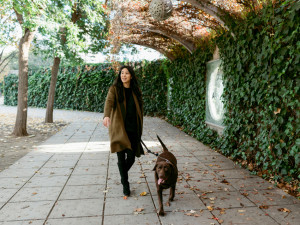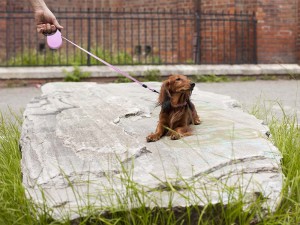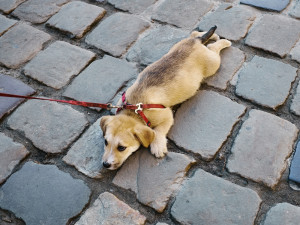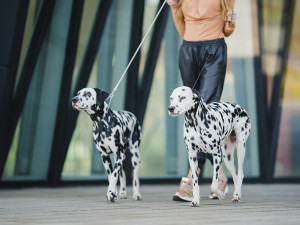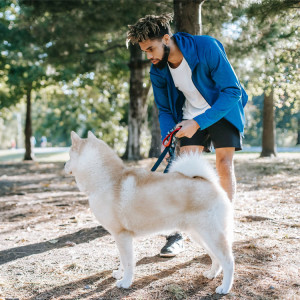10 Tips You’ll Definitely Want to Follow When You Walk Your Dog
From the safest gear to training recommendations
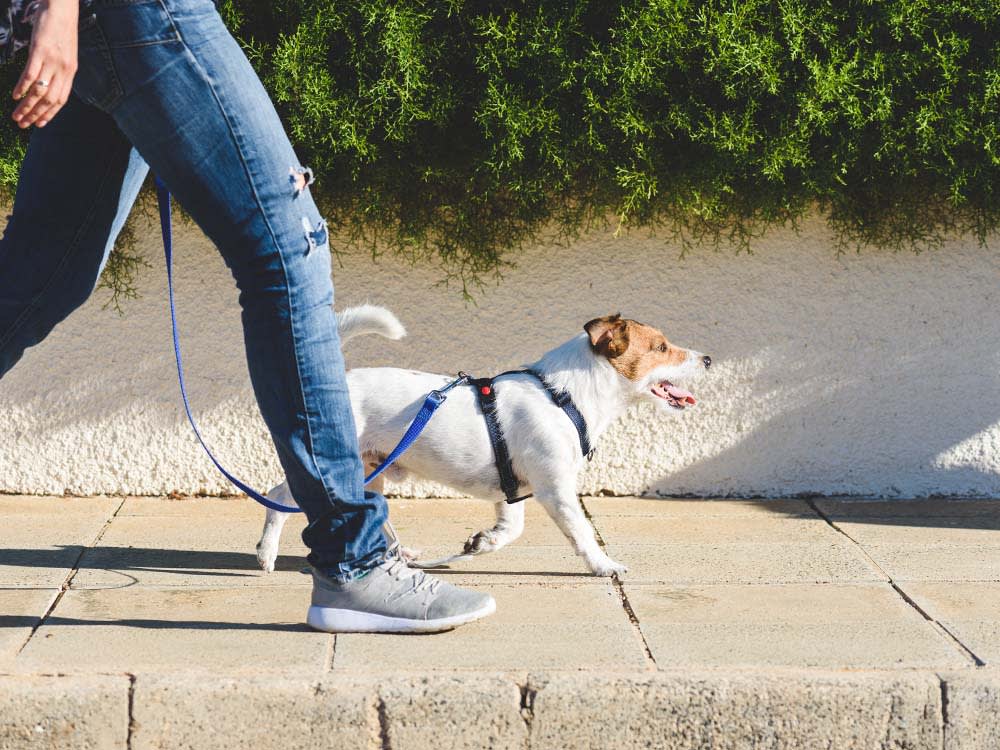
Share Article
Your dog probably has a small list of favourite things. Many of them probably include food and/or snuggling on the couch while you watch Bake Off, but there’s one thing that’s held the prime spot at the top of the list: walks.
So, you know that walks are the best part of your dog’s day, outside of that 4pm peanut butter-Kong snack they might get, but they might not always be that fun for you. Maybe your pup pulls on the lead or is reactive with other dogs also on their daily stroll. All of these things are totally normal obstacles to come across, but there are ways to make your life easier. Stay with us.
How can I make dog walks more enjoyable for both of us?
Going for a walk is the best part of your dog’s day (and hey, maybe it’s the best part of yours, too). If you’re a new pet parent, you might think dog walking is pretty simple. But the truth is, making a walk enjoyable for both you and your pup requires some foresight and training. Here are the top 10 dog walking tips you need to know.
1. Select the correct lead
One of the main issues new pet parents face is how to walk a dog who pulls on the lead. While training and practice are essential, the type of lead you have is also very important. Many dogs react poorly when they are tugged back, and their instinct is to pull even more. That’s where a front-clip harness comes in – it pulls your dog from the front so they won’t fight against it.
If your dog does the opposite and flattens to the ground, turns around or is otherwise spooked easily (many newly adopted dogs are considered flight risks on walks, especially in urban environments with lots of scary stimuli, from skateboards to buggies) martingale collars are designed to prevent an escape-artist dog from backing or slipping out of a flat collar or wiggling out of a harness (it happens more often than you think).
“Because this style of collar gets tighter when pulled, they are known for preventing a dog from slipping out, which is why they are a favourite of rescues. A martingale collar has an extra loop that you clip a lead into so that when pulled, it cinches the rest of the collar down evenly around the dog’s neck. The limited cinch is gentler than a ‘choke’ collar,” explains Anne Christian, the founder of Dog + Boneopens in new tab, who make customised martingale collars.
2. Start slow with puppies
When it comes to puppy walking, many people don’t realise that puppies can’t be walked very far, no matter their size. Twenty minutes is the maximum they should be out for at first. You can gradually build up to longer walks as your pup gets older and more mature.
3. Train your dog on walks
Walks are a great time to start training your dog in basic good behaviour. Dog walking training is a good way for your pup to meet new people, interact with other dogs, and get used to the outside world. You will need to be firm with them at the start using positive reinforcement, but they’ll soon get the hang of it. Everyone loves a puppy, but make sure you’re careful around children since you won’t know how your pup will react at first.
4. Stick to a routine
While your dog gets used to walking with you, it’s a good idea to stick to a routine. This means walking them at the same time each day and to the same places. This will help them learn how they are expected to behave and will help them behave better when you introduce them to new walking areas. It also helps dogs stay calm when they know where they are going.
5. Bring treats
Teaching your dog how to behave in public isn’t always the easiest thing, but it can be done. Knowing how and when to reward your pup is essential. A dog will listen to you when you have treats in your hand, so make sure that you only give them out when they’ve done something right, and not to get them to calm down. If you give your dog a treat every time they demand one, you’ll only reinforce the behaviour that you don’t want.
6. Know how much exercise your dog needs
The type of dog you have will determine how long you need to walk them for and what type of exercise they need, so be sure to do your research. Some breeds and mixes will be perfectly happy with a couple of small walks every day, while others will need to go somewhere they can run around for a long time to really let out their energy.
7. Be prepared
There are three items (besides a lead) that you should never leave home without. The first one is, of course, poo bags. Always clean up after your dog. Not only is it common courtesy, but if you don’t, you could be faced with a £100 fineopens in new tab. You should also have a bottle of water with you. Even when the weather isn’t warm, your dog can get dehydrated quickly. Finally, a toy that you can throw for them means that they’ll be able to run around for a bit and enjoy themselves.
8. Hire a dog walker
In an ideal world, you’d always walk your dog yourself – but unfortunately, this isn’t always possible. Most dogs need regular exercise and long walks, and if you can’t provide them, it’s best to look into hiring a professional dog walking company. Many dog walkers can also help you with dog training and have strict dog walking guidelines that they follow so you know your dog is in safe hands wherever they go.
9. Consider the weather
Making sure you’re aware of your surroundings and potential weather dangers is one dog walking tip that is often overlooked. Both the heat and the cold can really affect your dog, with some breeds more susceptible to weather changes than others. Having a jacket for your dog in the cold and watching their paws on the hot pavement in the sun is a must. Consider getting pet insurance, just in case anything does ever happen when you’re out walking.
10. Get a microchip for your dog
One of the most important dog walking tips is to have your dog microchipped. That way, you’ll be able to find them if they ever wander off or get lost. Having a collar with their name and your number on it is also a good idea.
Frequently asked questions
How often should I walk my dog?
Ideally, you should walk your dog every day for about an hour. Puppies should not be out for longer than about 20 minutes.
How can I ensure my dog’s safety during walks?
Be sure to use a front-clip harness or martingale collar and lead train your pup. Always bring water and look out for signs of heat-stroke and overexertion.
What should I not do when walking a dog?
Making sure you’re aware of your surroundings and potential weather dangers is one dog walking tip that is often overlooked. Keep an eye on your dog for signs of discomfort and heat exhaustion.
What should I bring on a dog walk?
There are three items (besides a lead) that you should never leave home without: poo bags, a bottle of water and a toy.
References
Gina Brugna
Gina Brugna and her husband Patric own and operate The Peaks Pet Nanny.
Related articles
![Dog lying on a brick street with a leash]()
“Why Won’t My Dog Walk Outside?”
Dog behaviourist Karen B London’s top tips to help get your parked pet moving
![Owner walking two Dalmatians downtown]()
How To Stop a Dog From Pulling on the Lead
Tug of war every time you head for a walk is not the one
![man unleashing dog in a park]()
6 Steps to Improve Your Dog’s Recall Training
Teach your pup a perfect recall so you can be sure they will come back, no matter what

